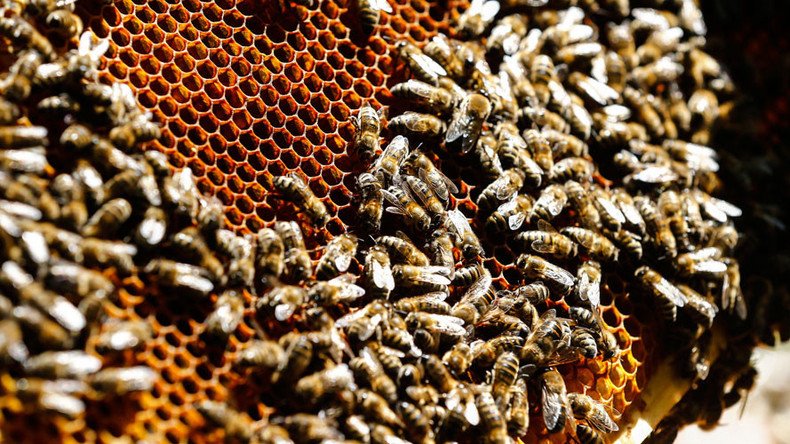Common pesticide kills up to 40% of sperm in bees, possibly leading to shrinking population – study

One of the most widely used insecticides has the side effect of killing a significant percentage of bee sperm, a new study suggests, potentially offering an explanation for a dramatic decline in the bee population.
Swiss scientists looked into how a class of neuro-active insecticides, known as neonicotinoids, may be affecting bees. Their findings were published on Wednesday in the Royal Society B’s journal Proceedings.
In their study, researchers divided bees into two groups, with the first being fed pollen treated with substances used in fields called thiamethoxam and clothianidin, and the second eating “clean” food. As 38 days passed, the test objects and their semen were examined.
Male bees, products of unfertilized eggs known as drones, turned out to be of particular interest to the scientists, as their primary role is to mate with a fertile queen.
The controlled experiment showed that drones that consumed pollen treated with neonicotinoids produced 39 percent less sperm than those that were not exposed to the substances.
“The widespread prophylactic use of neonicotinoids may have previously overlooked inadvertent contraceptive effects on non-target insects, thereby limiting conservation efforts” the study claims.
The reproductive function, however, wasn’t entirely broken off, but it clearly became tougher for the queen to conceive from the drones that had lost some of their virile strength, the researchers from the University of Bern noted.
“We did observe a significant negative effect on sperm viability, which in turn resulted in a significant reduction in the number of living sperm produced by neonicotinoid drones.
“This could have severe consequences for colony fitness, as well as reduce overall genetic variation within honeybee populations,” the scientists concluded.
The female bees, however, didn’t demonstrate any changes in fertility, the study added.
Apart from the negative effect on sperm, the life span of the bees that had been in contact with the insecticide saw a reduction as well – from 22 days to 15. The affect was attributed to immune system malfunction.
“Recent studies revealed that agrochemicals are capable of impairing immune function; therefore, it is possible that neonicotinoid-exposed drones possess reduced detoxification abilities that subsequently affected lifespan,” the study continues.
Colonies of pollinating insects have been dwindling in Europe and North America in a process known as “colony collapse disorder,” when the majority of worker bees abandon a queen and other immature bees, despite there being plenty of food to feed on.
The disorder has led to significant economic losses, since honeybees and other insects are responsible for pollinating three-quarters of the world’s food crops. Farmers renting bees for pollination services had incurred a cost increase of almost 20 percent (around 200 dollars per hive) due to bee shortages as of 2013.
In the same year, the EU commission introduced an EU-wide ban on widely-used insecticides. The matter raised much debate again in Britain, France and other countries in 2016, however.














